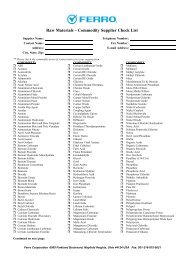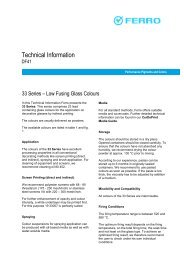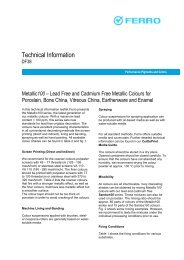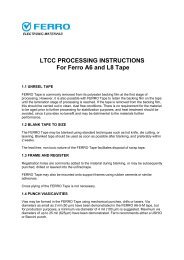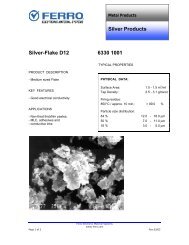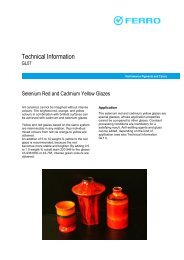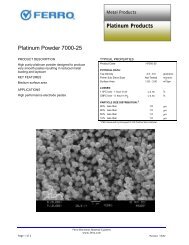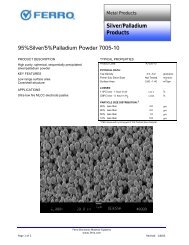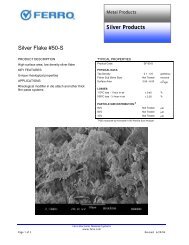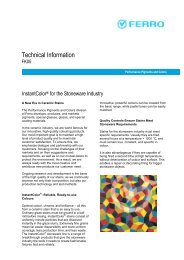Inorganic Pigments - Ferro
Inorganic Pigments - Ferro
Inorganic Pigments - Ferro
Create successful ePaper yourself
Turn your PDF publications into a flip-book with our unique Google optimized e-Paper software.
6<br />
Cool Colors<br />
Objects coloured with Cool Color ® pigments stay<br />
cooler. Several other advantages result from this<br />
fact:<br />
improved comfort levels for building occupants<br />
lower air conditioning costs, energy saving<br />
cooler cities<br />
the coloured parts are less subject to thermal<br />
expansion and contraction<br />
increased service life<br />
less product degradation<br />
intense colours available<br />
How does infrared reflection work?<br />
Approximately half of the radiation of the sun lies<br />
within the infrared region (fig. 1). The infrared<br />
radiation emitted by the sun is absorbed by roofs,<br />
walls, facades, and the like, leading to a heat buildup<br />
inside.<br />
Fig. 1: Solar radiation spectrum<br />
Fig. 2 illustrates the energy transfer from the out -<br />
side inside the building. All energy that is not<br />
reflected, convected or re-emitted, is conducted<br />
into the inside of the building and thus increases<br />
the interior temperature.<br />
Fig. 2: Energy transfer in buildings<br />
One possibility to work against this increasing<br />
temperature is a higher reflectance of the exterior<br />
surface of the building by coating it with a pigment<br />
that shows high infrared reflectance.<br />
Properties and Application<br />
Fig. 3 shows the solar reflectance spectra of the<br />
Cool Color ® pigments, measured in a PVDF system.<br />
While still a major portion of the visible light is<br />
absorbed and the pigment appears brightly<br />
coloured, the biggest difference to conventional<br />
pigments can be found in the infrared area. The IR<br />
reflective pigments of the Cool Color ® range reflect<br />
the infrared radiation to a great extend, almost as<br />
good as the white pigment titanium dioxide,<br />
whereas carbon black or other black pigments<br />
absorb almost all infrared light.<br />
Therefore objects coated with Cool Color ® -pigments<br />
do not absorb as much solar energy and stay cooler.<br />
Of course every pigment has a different reflectance<br />
spectrum. The percent of solar reflectance is the<br />
important figure. Whereas carbon black has a solar<br />
reflectance of 5 %, the solar reflectance of <strong>Ferro</strong>s<br />
Cool Color ® pigments is significantly higher.



